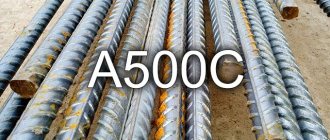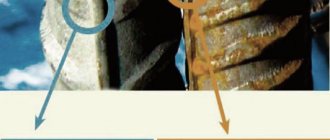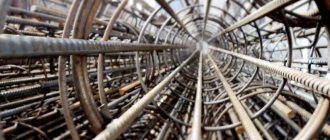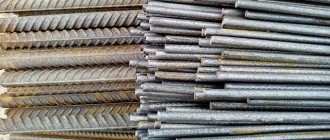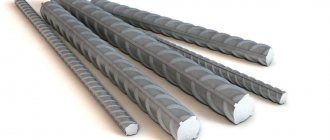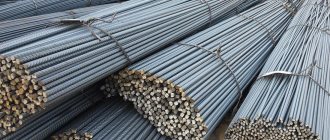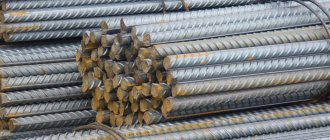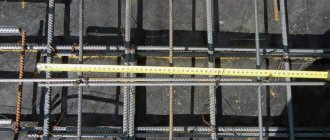Choosing suitable building materials is not an easy task even for experienced professionals, let alone those who are building something for themselves. The developer is often faced with a choice between A400 and A500C reinforcement. In many ways they are similar and have the same properties. In the article we will analyze the differences between the a400 and a500c fittings, and help you choose the appropriate solution for your facility.
Class A500C and A3 fittings: explanation, differences and characteristics
During construction, it often happens that you need to use welding. Reinforcement bars that are not demanding on welding conditions are a real gift for the builder. A huge advantage of A500C is that it does not have brittle fractures of seams when using manual arc welding. Therefore, this product is perfect for this. Some people ask: is A500S fittings A1 or A3? We dispel this misconception and inform you that all three of these rods are different, both in appearance and in technical characteristics.
So, why does A500C have such excellent welding characteristics? The thing is that this type of product is made of steel with a low carbon composition, and for welding this is an important indicator. A3, in turn, was developed in the middle of the 20th century and cannot boast of such properties. It contains 0.2-0.37% carbon, which does not allow it to be used in a wide range of welding operations. Such reinforcement is considered to be weldable to a limited extent. If you use A3 instead of A500C, this may lead to rapid destruction of the building or its individual elements. Some countries generally prohibit the use of reinforcement with a carbon content above 0.2% when welding.
However, this is not all that distinguishes the two classes of fittings. A500C has a yield strength of 500 N/mm2, and A3 - 400 N/mm2. According to calculations, it turns out that using A500C is much more profitable, and the savings are about 20%. It is not surprising that many domestic manufacturers who produce rolled metal products have switched to A500C, which is more in demand nowadays due to its high resistance.
To be honest, the first years of production were not without difficulties. For some time, it was impossible to distinguish between the two classes of rolled metal products in appearance - they had the same profile. There was also no factory marking, so such fittings had to be subjected to laboratory tests.
How to distinguish A500C from A3 fittings visually
A3 fittings. A400 has a periodic profile, which is 2 mm larger in diameter than A500C. It looks like this: transverse protrusions intersect 2 longitudinal ribs. This type forms additional adhesion zones with concrete, in turn making the structure more durable. Such fittings are used in all types of construction and repair work. It is made of steel 25GS.
A500S fittings. Such rods are made from steel 35GS or 35G2S. These products have fewer alloying components, so their price is up to 15% lower than that of analogues. And if you buy in bulk, the benefits will be even more tangible. The surface of the reinforcement is of a periodic profile, where longitudinal ribs may or may not be present. The crescent-shaped transverse protrusions do not contact them. Recommended for frame formation. The letter “C” indicates that such fittings are suitable for welding. We believe that now the question “A3 and A500S fittings, what is the difference between them” will no longer arise for you.
| Parameter | Reinforcement class | |
| А500С | A3 | |
| Used steel stamps | ZPS | 35GS,25G2S |
| Percentage of carbon in composition | 0,22% | 0,20-0,36% |
| Deformation limit | 500 N/mm2 | 400 N/mm2 |
| Tensile strength | 600MPa | 590 MPa |
| Tensile resistance | 450 MPa | 365 MPa |
| Maximum negative temperature indicator | Up to -55 0C | Up to -40 0C |
| Profile type | Crescent | Annular |
Metal grades.
The production of rods of the A500C series is regulated by the regulatory document GOST 52544-2006.
Class 3PS steel contains a small amount of alloying elements, which makes it possible to achieve excellent strength indicators, significant savings in raw materials and an acceptable cost of rod reinforcement. Low carbon content (up to 0.22%) contributes to high-quality weldability and formability of reinforcing elements. Such joints exhibit good ductility with a complete absence of brittle fractures. The ability to use arc welding is an undoubted advantage of the A500C fittings. The A3 series steel rod is produced in accordance with GOST 5781-82. It is based on metal with a low carbon content (35GS and 25G2S), which significantly narrows the range of application possibilities. A3 reinforcement is classified as limitedly weldable. Replacing A500C rods with it in some situations creates a potential danger for the objects being built.
Scope of use of fittings
A3 reinforcement is intended for load-bearing structures of reinforced concrete structures. In residential construction, it is used to strengthen foundations, interfloor ceilings, load-bearing columns and walls. In industry, a3 and a500c reinforcement is used for the construction of load-bearing structures of complex shapes: bridges, dams, tank walls and other structures.
It should be noted here that the a400 and a500 fittings have another important difference - the a500 has increased corrosion resistance. Alloying additives allow steel to better cope with the active chemical environment. A400 is not so good in this regard, and it is not recommended for use in some types of concrete and in climatic conditions with high humidity and high temperature changes.
Characteristics and differences between steel 25G2S and 35GS
We are often asked the question, which A3 reinforcement is better to buy and what is the difference between 25G2S and 35GS steel? The main difference between the grades is the percentage of alloying elements, but you need to know that in both steels there should be less than 0.3% nickel, chromium and copper, phosphorus - up to 0.04%, maximum sulfur concentration - 0.045%). Reinforcement 25G2S has better weldability; it can be welded manually, which is of great practical value in the construction industry; 35GS is used mainly for tying into frames.
| Features | Reinforcement A3, st. 25g2s | Reinforcement A3, st. 35gs |
| Weldability | weldable | conditionally weldable |
| Chemical composition, in% | ||
| C (carbon) | 0,20 — 0,32 | 0,30 — 0,37 |
| Mn (manganese) | 1,20 — 1,60 | 0,80 — 1,20 |
| Si (silicon) | 0,60 — 0,90 | 0,60 — 0,90 |
A500C corrugated fittings areas of application
Manufacturers produce and sell a wide range of rolled metal products, one of the most popular types of which is fittings. Buyers are provided with smooth and corrugated fittings, which are divided into six classes. Corrugated fittings A500C , which are distinguished by advantageous technical characteristics, are in high demand.
Description, decoding, GOST
The A500C reinforcement is a bar with a periodic profile, a surface with two longitudinal ribs that do not intersect with the crescent-shaped transverse protrusions. The distance between the protrusions and their angle of inclination differs depending on the rental manufacturer. For production, steel grades St3SP, St3PS, St3GPS are used, the chemical composition of which contains no more than 0.22% carbon. Production is carried out in accordance with GOST R 52544-2006.
The explanation of the A500C marking (according to the state standard) is as follows:
- the letter “A” indicates that this material is thermally and mechanically reinforced hot-rolled reinforcing bars;
- the letter “C” demonstrates the possibility of using welding technology for fixing reinforcement elements;
- 500 is the minimum yield strength of the material, measured in N per sq. mm.
Features, Benefits
fittings have a large number of advantages. In addition, reinforcing bars are distinguished by several characteristics that can be considered as advantages of rolled products of this class. The following are the main, most important properties of both types:
- durability inherent in rolled steel produced in accordance with the required standards;
- high strength, toughness and minimal fragility, which are achieved due to the absence of fragile places where destruction of products is possible;
- good weldability does not require additional measures to fix rolled steel during the manufacture of various structures;
- low production costs have a positive effect on the final rental price;
- unification, versatility - the ability to replace fittings of other classes: A240, A300, A400, the characteristics of the A500C make up for
- weaknesses of the presented species;
- thermal stability, providing excellent parameters of plasticity and cold resistance;
- the relief surface guarantees excellent adhesion to concrete, which ensures the popularity of reinforcement in construction,
as well as other areas of activity.
Areas of application
The advantages of A500C reinforcement, its unique parameters of durability, ductility and viscosity determine the areas of its use: 1. A500C reinforcement is most widely used in construction. Strengthening reinforced concrete structures, reinforcing walls and floors, pillars, foundations, flights of stairs and landings, beams and other elements of buildings for various purposes: residential, civil, industrial. 2. Manufacturing and erection of metal structures of various types: fences, gratings, stairs, etc. 3. Creation of practical, functional and decorative elements. 4. Production of non-slip products. Assortment
Several parameters are noted, according to which the A500C fittings are divided:
- Diameter. Reinforcing bars are produced in diameters from 4.5 to 50 mm, typical sizes are from 6 to 40.
- Depending on the diameter, the nominal weight of 1 meter of rolled length varies, which ranges from approximately 0.099 to 9.865 kg, as well as the cost. The larger the diameter, the lower the rental price.
- Delivery form. Reinforcement with a cross-sectional diameter up to 6 mm. supplied in coils, 6-12 - in coils and rods, over 12 - sold exclusively in rods.
- Length. The standard size of the rods is 6.05 and 11.75 meters. At the request of the client, it is possible to produce rods up to 25 meters.
Differences from A400
A500C class reinforcement is often compared with A400 rods. Both classes of rods are included in category A-III; rolled products are used in the construction of residential buildings up to 80 tons. Often the fittings of these classes are considered similar and even the same, but there are significant differences:
- Scope of application. Both A500C and A400 are successfully used in construction, repair and finishing, creating frames, and producing reinforced concrete products.
BUT A500S can be used to strengthen loaded and unloaded structures, and A400 - only in high-voltage elements.
- Specifications. The difference in properties is visible from the markings. The yield strength is 400 and 500 N/sq.mm. respectively.
As a result, class 1 reinforcement cannot be welded. Therefore, only binding wire can be used to connect the rods.
- Appearance. A500C - a rod with two longitudinal ribs and transverse crescent-shaped protrusions. Type of rental profiles
A400 is different and can be sickle-shaped with two curved or four ribs, ring-shaped with semicircular ribs located at a slight angle.
Advantages of working with us:
- — wholesale and retail sales
- - low prices
- — quality guarantee for all products sold
- — payment in any way convenient for you
- — delivery service at low prices
To complete the purchase of rolled metal, fill out an online application or contact our specialists for help at the following phone numbers: +7,
A3 fittings
The number next to the letter “A” means the presence or absence of corrugation on the surface of the reinforcement. As mentioned earlier, A3 reinforcement has a corrugated surface. Wherever concrete is involved, you can find this particular type of reinforcement, because it is the most popular and most used, due to the fact that it increases the strength of the structure.
A3 fittings
Being the most popular type of reinforcement, it is used in the manufacture of reinforced concrete products, as well as monolithic construction.
Class A3 fittings are made of hot-rolled steel, but in some cases, A3 fittings can be made of high-alloy steel, which contains impurities:
- Titan.
- Chroma.
- Silicon.
- Manganese.
Thanks to this composition, the strength of the material increases, which means that the use of A3 reinforcement significantly increases the performance properties of building structures.
Wherever the type of reinforcement in question is used, resistance to both atmospheric and mechanical influences increases.
The main requirement that applies to such reinforcement is good adhesion to concrete and resistance to corrosion.
Dimensions
Both types of rolled products for reinforcement are supplied in different forms - measured or unmeasured. They can be packaged in the form of rods (rods) in bundles, each of which is tightly tied and usually weighs 4-8 tons. If the thickness of the rolled product allows (that is, the diameter is small), then flexible corrugated products are rolled into coils, coils weighing 0.8-1.5 tons. They are also secured with steel wire.
The reinforcement is stored in special storage areas equipped with linings and shelter in case of rain.
But the sizes of two types of reinforcing bars, all other things being equal, are not always the same. They are equal in rods - rods can have a diameter from 10 to 40 millimeters for both types of fittings for sale. With thin rolled products the question is somewhat different. Due to the difference in flexibility and processing of steel, A500C can be coiled if the cross-sectional diameter is 6-14 millimeters, and A3 only if it is 6-12 millimeters.
